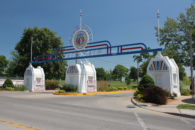The Missouri State Fair has been challenged over its history by war, weather, and a pandemic. One year, however, the fairgrounds and surrounding community were jeopardized by a music festival almost universally declared a “disaster.”
The Ozark Music Festival, a three-day-long event held on the fairgrounds in July 1974, was one of the country’s largest music festivals — and by most accounts one of the most destructive. It boasted a roster including Aerosmith, Bachman-Turner Overdrive, Lynyrd Skynyrd, The Eagles, and a host of popular rock bands of the day and was promoted by famed DJ Wolfman Jack.
Missouri State Fair Director Mark Wolfe said the event was a dark moment in the fair’s history and one that would not be repeated.
“That did not turn out well, but it’s certainly a point in history for the fair,” Wolfe said. “It was an event that got out of control and basically overwhelmed a small rural community. We’ve had entertainers at the fair in my time that mentioned they remembered being here for it. We’re not going to repeat it, I promise you that.”
Advertised as a bluegrass and pop-rock festival to the Department of Agriculture and the Sedalia Chamber of Commerce, the idea was broached by Musical Productions, Inc., which touted a maximum of 50,000 attendees. Turnout to the event far exceeded expectations; ticket sales surpassed the company’s estimate by 10,000 units prior to the event, and thousands lined up outside the fairgrounds the evening before it began. By some estimates, more than 350,000 people ended up packing the fairgrounds that weekend.
The festival descended into chaos with 2,500 patients reportedly treated for medical issues and medical staff and National Guardsman working up to 20 hours a day to help attendees.
The turmoil spread into the Sedalia community as well: The nearby Pittsburgh Corning Plant halted production due to traffic backups which hindered employees from making it to work. Other businesses, including stores and hotels, reported damage and business interruptions, with more than 30 shopping carts going missing from the State Fair Shopping Center, it’s been said.
Even the interstate was choked with festival-goers stopped along the side of the road to rest the week after the festival ended.
With just a few weeks to prepare the grounds for that year’s fair, portions of the grounds were bulldozed while heaps of garbage were hauled away to local landfills. More than $100,000 in damages to the fairgrounds and surrounding areas were estimated to have occurred. Allegedly, helicopters sprayed lime over the fairgrounds to mitigate the possible spread of disease.
Despite the chaos, the fair was still held on the grounds that year, leaving 1943 and 1944 the only years the fair was canceled due to World War II.
The festival was infamous enough to catch the attention of the Missouri Legislature. Lawmakers assembled a committee, aptly dubbed the Select Senate Committee Investigating the Rock Festival, to analyze the event. A 67-page report was filed that October, decrying the event and the breakdown in communication between organizers, law enforcement, and the state.
“The Ozark Music Festival can only be described as a disaster,” the report said. “While misrepresentations were made by the promoters at various stages of negotiations and preparations, the true nature of the event should have been clear.”
The committee called for the creation of a Division of Drug and Crime Control within the Missouri State Highway Patrol which was finally established nearly a decade later — the result of more than 1,000 drug overdoses reported from the festival.
The festival remains a sore subject for the community nearly 50 years later, according to Wolfe, who said he looked forward to more peaceful events on the fairgrounds as this year’s celebration begins.
Cover image: vintageeveryday.com

Cameron Gerber studied journalism at Lincoln University. Prior to Lincoln, he earned an associate’s degree from State Fair Community College. Cameron is a native of Eldon, Missouri.
Contact Cameron at cameron@themissouritimes.com.































